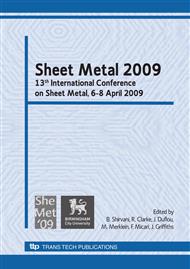[1]
R. Srinivasan: Yield points during the high temperature deformation of Ti-15V-3Al-3Cr-3Sn alloy. Scripta. et Mater. Vol. 27 (1992), p.925.
DOI: 10.1016/0956-716x(92)90418-e
Google Scholar
[2]
M. N. Vijayshankar and S. Ankem: High temperature tensile deformation behaviour of β-Ti alloys. Mater. Sci. Eng. Vol. 129A(1990), p.229.
Google Scholar
[3]
P. Griffiths and C. Hammond: Superplasticity in large grained materials. Acta Metall. Vol. 20 (1972), p.935.
DOI: 10.1016/0001-6160(72)90087-9
Google Scholar
[4]
T. Furuhara, B. Poorganji, H. Abe and T. Maki: Dynamic recovery and recrystallisation in titanium alloys by hot deformation. JOM Vol. 59 (2007), p.64.
DOI: 10.1007/s11837-007-0013-8
Google Scholar
[5]
G. C. Morgan, and C. Hammond: Superplastic deformation properties of β-Ti alloys. Mater. Sci. Eng. Vol. 86(1987), p.159.
Google Scholar
[6]
V. V. Balasubrahmanyam and Y. V. R. K. Prasad: Deformation of beta titanium alloy Ti-10V-4. 5Fe-1. 5Al in hot upset forging. Mater. Sci. Eng. Vol. 336A(2002), p.150.
DOI: 10.1016/s0921-5093(01)01982-7
Google Scholar
[7]
I. Philippart and H. J. Rack: High temperature dynamic yielding in metastable Ti-6. 8Mo- 4. 5Fe-1. 5Al. Mater. Sci. Eng. Vol. 243 A(1998), p.196.
DOI: 10.1016/s0921-5093(97)00800-9
Google Scholar
[8]
A. H. Cottrell and B. A. Bilby: Dislocation theory of yielding and strain ageing of iron. Proc. Phys. Soc. Vol. 62 A(1949), p.49.
DOI: 10.1088/0370-1298/62/1/308
Google Scholar
[9]
J. J. Gilman: Dislocation Sources in Crystals. J. Appl. Phys. Vol. 30(1957), p.1584.
Google Scholar
[10]
W. G. Johnston and J. J. Gilman: Dislocation Velocities, Dislocation Densities, and Plastic Flow in Lithium Fluoride Crystals. J. Appl. Phys. Vol. 30 (1957), p.129.
DOI: 10.1063/1.1735121
Google Scholar
[11]
I. Weiss and S. L. Semiatin: Thermomechanical processing of beta titanium alloys-an overview. Mater. Sci. Eng. Vol. 243A(1998), p.46.
Google Scholar
[12]
I. Philippart and H. J. Rack: High temperature, high strain deformation behaviour of Ti-6. 8Mo-4. 5Fe-1. 5Al. Mater. Sci. Eng. Vol. 243 A(1998), p.253.
Google Scholar
[13]
S. L. Semiatin, et al: Self-consistent modelling of the flow behaviour of wrought alpha/beta titanium alloys under isothermal and nonisothermal hot-working conditions. Metall. Mater. Trans. Vol. 33 A(2002), p.2719.
DOI: 10.1007/s11661-002-0394-9
Google Scholar
[14]
S. Nemat-Nasser, W. G. Guo and J. Y. Cheng: Mechanical properties and deformation mechanisms of a commercially pure titanium . Acta Mater. Vol. 47(1999), p.3705.
DOI: 10.1016/s1359-6454(99)00203-7
Google Scholar
[15]
D. François, A. Pineau and A. Zaoui: Mechanical of Materials, Vol. 1: Elasticity and Plasticity ( Kluwer Academic Publishers, Netherland 1998).
Google Scholar
[16]
G. T. Hahn, G. T.: A model for yielding with special reference to the yield-point phenomena of iron and related BCC metals. Acta Metall. Vol. 10 (1962), p.727.
DOI: 10.1016/0001-6160(62)90041-x
Google Scholar
[17]
S. Kohda: Introduction to Metal Physics (Corona Publishing Inc, Tokyo 1973).
Google Scholar
[18]
F. Yoshida: A constitutive model of cyclic plasticity. Int. J. Plastic. Vol. 16 (2000), p.359.
Google Scholar
[19]
F. Yoshida, Y. Kaneda and S. Yamamoto: plasticity model describing yield-point phenomena of steels and its application to FE simulation of temper rolling. Int. J. Plastic. Vol. 24 (2008), p.1792.
DOI: 10.1016/j.ijplas.2008.05.004
Google Scholar
[20]
H. B. Sun, et al: Effect of strain rate on Lüders band propagating velocity and Lüders strain for annealed mild steel under uniaxial tension. Mater. Lett. Vol. 57 (2003) , p.4535.
DOI: 10.1016/s0167-577x(03)00358-6
Google Scholar
[21]
H. B. Sun, et al: Finite element simulation on the propagation of Luders band and effect of stress concentration. Mater. Lett. Vol. 57 (2003), p.3206.
Google Scholar
[22]
J. L. Chaboche: Constitutive equations for cyclic plasticity and cyclic viscoplasticity. Int. J. Plastic. Vol. 5 (1989), p.247.
DOI: 10.1016/0749-6419(89)90015-6
Google Scholar


